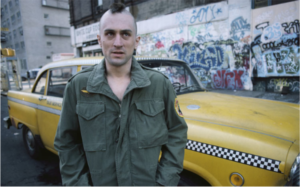By Connor Mirabella || Staff Writer

Released in 1976, Taxi Driver is one of both Martin Scorsese and Robert DeNiro’s most famous projects before either innovator was nearly as well known or as established talents as they are now. This was not the first time these two future stars had worked together either as they joined forces in “Mean Streets” just three years prior for a raucous picture about the rough side of life in New York City during the ’70’s. The pair take viewers on an oddly subtle yet auspicious whirlwind of the internal struggle for purpose that seems to define the inner city modern experience with Taxi Driver, and it is no surprise that it’s been a cult classic ever since.
DeNiro makes use of his slow narration style to lay out the setting of Travis Bickle’s life. Vietnam veteran and insomniac, Bickle (played by DeNiro) begins driving taxis at night to make use of his time while unable to sleep. He isolates himself and is a bit of a loner, but far from being a tormented character as much as he seems a wanderer. Frequenting the city’s porn theaters at night and often having grandiose thoughts of prescribed meaning, Bickle narrates parts of this movie as if he were writing it in a letter. The words are said slowly and deliberately, as if they have been carefully chosen whether or not there is actually anything significant about what is being said. Bickle’s insomnia inflates his search for purpose, resulting in a desire to take action rather than frustration, as it would in most. Travis Bickle becomes consumed with the concept of carrying out a grand mission and doing something important in the world, not only to give his own existence meaning and his life importance but also to respond to the horrifying things he witnesses driving his cab.
Bickle is all consumed by his thoughts, which reflect his off-color perspective and disconnect from reality. Is an insomniac cab driver to blame for being cynical in some of the worst neighborhoods of New York City during the 1970s? He witnesses abuse, violence, and disgusting behavior that’s often meant to be disrespectful towards him if not by coincidence. Cab drivers fade into the background for some, especially those in big cities. This happens today with cabs, Lyft, and Uber but there’s a difference when people order rides on their phone and have an app connect them. Living in a crowded city with nothing but cabs that are frequently the best way to get around leads to this becoming a normal facet of life that does not require any change in one going about their business. As a result, many people go about their business in the back of the cab, but Travis Bickle never quite blinks an eye. He has opinions on these things but he seems unfrustrated and unphased by the behavior in front of him during the moment. The cumulation of this experience for Bickle results in an ending that feels like the free fall of a ride after you’ve been climbing steadily but don’t know what is actually coming at the end of the ledge. The score, written by the late Bernard Herrmann, is absolutely crucial to the meaning and prolonged engaging features of this film. The music is not only beautifully composed but it is also very specifically controlled in how dramatically it sets the mood. The more times I watch this film, the more I see half of the plot carefully laid out in a beautiful score that I still have saved on my phone. This film is the perfect cocktail of original and deliberate directing with intensely researched acting and one of the most superb movie scores I have ever heard. This particular motion picture took me some time after my initial viewing to fully understand because of the subtlety in Scorsese’s directing that combines with his graphically realistic style, but it is a thriller worth recommending to anybody who has the patience to enjoy this incredibly relevant masterpiece in our day and age of American violence, weapons, and frustration.
Junior Connor Mirabella is a Staff Writer. His email is jmirabel@fandm.edu.